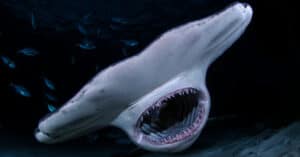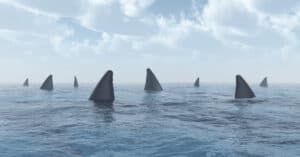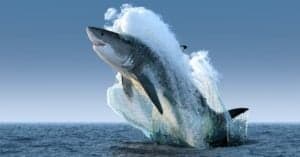Are Hammerhead Sharks Dangerous?
@media (min-width: 481px) {
.mobile-top-content {
display: none;
}
}
#mobileTopContentCTACarouselControls { overflow: hidden; text-overflow: ellipsis; white-space: nowrap; }
.mobile-top-content .more { color: #fff; }
.mobile-top-content a { color: #fff; text-decoration: underline; }
.mobile-top-content a:hover { color: #fff; text-decoration: underline; }
@media (max-width: 480px) {
.mobile-top-content {
background-color: #06a10b;
color: #fff;
text-align: center;
/*height: 60px;
padding-top:5px;*/
font-size:80%;
/* display: block; */
margin: 0px -30px;
}
}
Sphyrnidae sharks, more generally known as hammerhead sharks, have one of the most striking and odd features of any shark. For the most part, hammerhead sharks are harmless to people. Even so, few attacks have been documented. Their huge size and ferocity make them dangerous.
Are Hammerhead Sharks Dangerous?
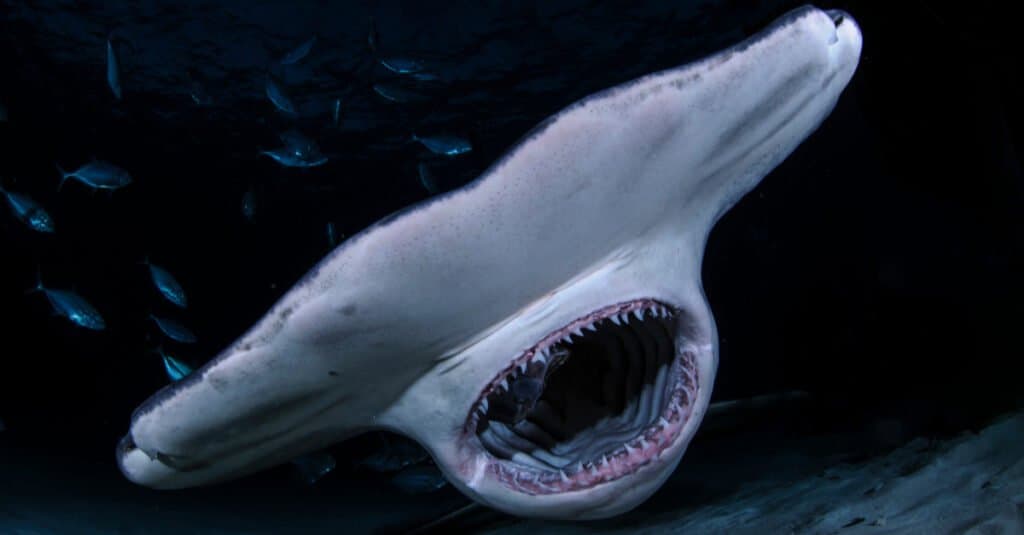
Martin Voeller/Shutterstock.com
Even though hammerhead sharks are not hostile toward humans, they are nevertheless dangerous and should be avoided at all times. It is estimated that only a very small number of human attacks have ever been seen. Although they don’t actively seek human victims, when invaded, they will attack a human.
Has A Hammerhead Shark Ever Killed A Person?
As far as records go, seventeen humans have been victims of attacks by hammerhead sharks that were not provoked. According to the International Shark Attack File, there have been no verified human deaths from hammerhead shark attacks.
button.pulse {
transform: scale(1); animation: pulse 2s infinite;
box-shadow: 0 0 0 0 rgba(11, 247, 25, 1);
}
@keyframes pulse {
0% { transform: scale(0.90); box-shadow: 0 0 0 0 rgba(11, 247, 25, 0.5); }
60% { transform: scale(1); box-shadow: 0 0 0 15px rgba(11, 247, 25, 0); }
100% { transform: scale(0.90); box-shadow: 0 0 0 0 rgba(11, 247, 25, 0); }
}
What Do Hammerhead Sharks Eat?

A-Z-Animals.com
Smaller fish are the main food of hammerhead sharks. They also enjoy squid, stingrays, and eels. Hammerhead sharks hunt crustaceans, including octopuses, using their powerful jaw. These sharks are formidable predators that hunt a wide variety of marine life in tropical environments.
Which Shark Is The Most Aggressive?
Bull sharks, tiger sharks, and the well-known great white shark are the three most common sharks to attack humans. Many shark experts consider bull sharks to be the most lethal sharks in the ocean.
How Big Is A Hammerhead Shark?
The bonnethead, a member of the hammerhead genus, grows an average of only three feet long, whereas the great hammerhead can grow to be over twenty feet long!
Where Do Hammerhead Sharks Live?

EDGAR PHOTOSAPIENS/Shutterstock.com
Marine hammerhead sharks can be found in tropical and temperate waters close to shore and above continental shelves. A possible seasonal migration can be observed, with birds moving toward the equator in the winter and away from the poles during the summer.
How Long Have Hammerhead Sharks Been Around?
Hammerhead sharks have been documented in the fossil record dating back at least twenty million years. According to some sources, this group initially appeared 33.9 million years ago!
Are Hammerhead Sharks Endangered?
There are some regions where hammerhead sharks are endangered. Conservation efforts must be enhanced and fishing restrictions imposed to reduce the threat to hammerhead sharks.
Can You Keep A Hammerhead Shark As A Pet?
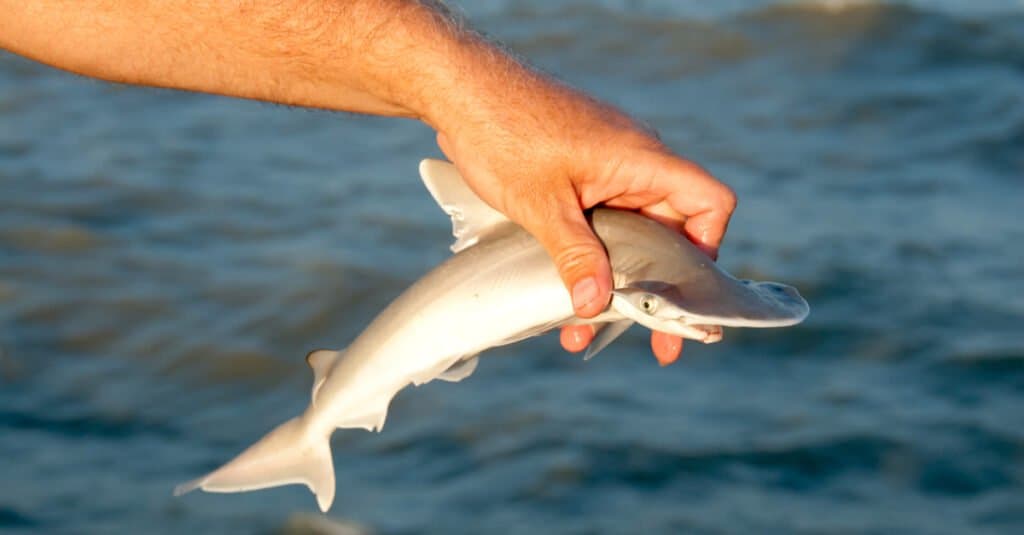
starryvoyage/Shutterstock.com
Hammerhead sharks are not suitable as pets. Even the smaller species can grow to be three feet long, so you’ll need an exceptionally large tank to host them comfortably. They’d have to be kept separate from the other fish in the aquarium because they’d consume them.
Does A Hammerhead Shark Attack With Its Head?
Hammerhead sharks are apex predators who use their unusually shaped heads to aid in their hunt for prey. A new study claims that the hammerhead shark’s abnormally curved snout developed to improve the animal’s vision and hunting abilities.
These wide-head sharks have stronger binocular vision, allowing them to track fast-moving prey with significantly greater precision. If their prey isn’t swimming right in front of them, they both detect and monitor better than other sharks. They also use their massive heads to weigh down their struggling prey.
FAQs (Frequently Asked Questions)
Did You Know?
Hammerhead Sharks can swim on their side. Rolling over is also a strategy used by hammerhead sharks to conserve energy. The dorsal fin on a shark’s back, like the rudder on a boat, aids in fast turns.
More from A-Z Animals
.more-snake-card-image { max-height:140px !important; }
@media (min-width: 481px) {
.mobile-top-content {
display: none;
}
}
#mobileTopContentCTACarouselControls { overflow: hidden; text-overflow: ellipsis; white-space: nowrap; }
.mobile-top-content .more { color: #fff; }
.mobile-top-content a { color: #fff; text-decoration: underline; }
.mobile-top-content a:hover { color: #fff; text-decoration: underline; }
@media (max-width: 480px) {
.mobile-top-content {
background-color: #06a10b;
color: #fff;
text-align: center;
/*height: 60px;
padding-top:5px;*/
font-size:80%;
/* display: block; */
margin: 0px -30px;
}
}
Sphyrnidae sharks, more generally known as hammerhead sharks, have one of the most striking and odd features of any shark. For the most part, hammerhead sharks are harmless to people. Even so, few attacks have been documented. Their huge size and ferocity make them dangerous.
Are Hammerhead Sharks Dangerous?

Martin Voeller/Shutterstock.com
Even though hammerhead sharks are not hostile toward humans, they are nevertheless dangerous and should be avoided at all times. It is estimated that only a very small number of human attacks have ever been seen. Although they don’t actively seek human victims, when invaded, they will attack a human.
Has A Hammerhead Shark Ever Killed A Person?
As far as records go, seventeen humans have been victims of attacks by hammerhead sharks that were not provoked. According to the International Shark Attack File, there have been no verified human deaths from hammerhead shark attacks.
button.pulse {
transform: scale(1); animation: pulse 2s infinite;
box-shadow: 0 0 0 0 rgba(11, 247, 25, 1);
}
@keyframes pulse {
0% { transform: scale(0.90); box-shadow: 0 0 0 0 rgba(11, 247, 25, 0.5); }
60% { transform: scale(1); box-shadow: 0 0 0 15px rgba(11, 247, 25, 0); }
100% { transform: scale(0.90); box-shadow: 0 0 0 0 rgba(11, 247, 25, 0); }
}
What Do Hammerhead Sharks Eat?

A-Z-Animals.com
Smaller fish are the main food of hammerhead sharks. They also enjoy squid, stingrays, and eels. Hammerhead sharks hunt crustaceans, including octopuses, using their powerful jaw. These sharks are formidable predators that hunt a wide variety of marine life in tropical environments.
Which Shark Is The Most Aggressive?
Bull sharks, tiger sharks, and the well-known great white shark are the three most common sharks to attack humans. Many shark experts consider bull sharks to be the most lethal sharks in the ocean.
How Big Is A Hammerhead Shark?
The bonnethead, a member of the hammerhead genus, grows an average of only three feet long, whereas the great hammerhead can grow to be over twenty feet long!
Where Do Hammerhead Sharks Live?

EDGAR PHOTOSAPIENS/Shutterstock.com
Marine hammerhead sharks can be found in tropical and temperate waters close to shore and above continental shelves. A possible seasonal migration can be observed, with birds moving toward the equator in the winter and away from the poles during the summer.
How Long Have Hammerhead Sharks Been Around?
Hammerhead sharks have been documented in the fossil record dating back at least twenty million years. According to some sources, this group initially appeared 33.9 million years ago!
Are Hammerhead Sharks Endangered?
There are some regions where hammerhead sharks are endangered. Conservation efforts must be enhanced and fishing restrictions imposed to reduce the threat to hammerhead sharks.
Can You Keep A Hammerhead Shark As A Pet?

starryvoyage/Shutterstock.com
Hammerhead sharks are not suitable as pets. Even the smaller species can grow to be three feet long, so you’ll need an exceptionally large tank to host them comfortably. They’d have to be kept separate from the other fish in the aquarium because they’d consume them.
Does A Hammerhead Shark Attack With Its Head?
Hammerhead sharks are apex predators who use their unusually shaped heads to aid in their hunt for prey. A new study claims that the hammerhead shark’s abnormally curved snout developed to improve the animal’s vision and hunting abilities.
These wide-head sharks have stronger binocular vision, allowing them to track fast-moving prey with significantly greater precision. If their prey isn’t swimming right in front of them, they both detect and monitor better than other sharks. They also use their massive heads to weigh down their struggling prey.




